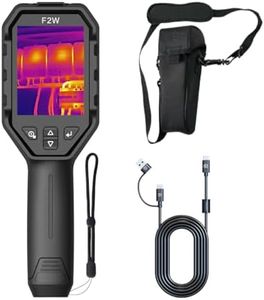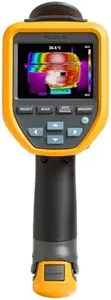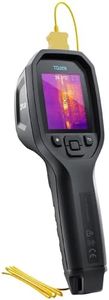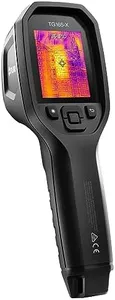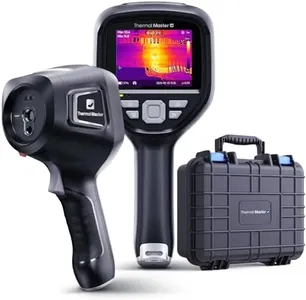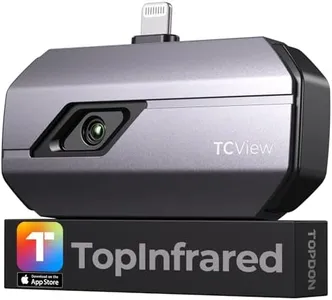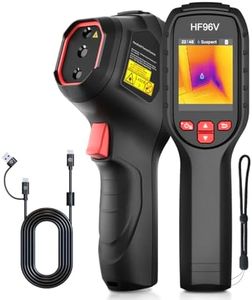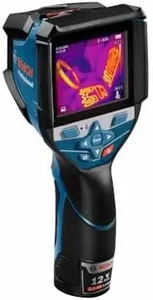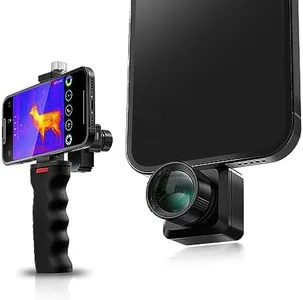10 Best Thermal Cameras 2025 in the United States
Our technology thoroughly searches through the online shopping world, reviewing hundreds of sites. We then process and analyze this information, updating in real-time to bring you the latest top-rated products. This way, you always get the best and most current options available.

Our Top Picks
Winner
HF96 Thermal Camera with Laser Pointer, Intelligent Scene Detection, Super Resolution 240 x 240, Thermal Imaging Camera96 x 96 IR Resolution, 25 HZ Infrared Camera, -4°F~1022°F,11h Runtime
Most important from
933 reviews
The HSFTOOLS HF96 Thermal Camera offers a range of impressive features, making it suitable for various inspection scenarios. It boasts a super resolution enhancement from 96x96 to 240x240, which significantly improves image clarity, making it easier to identify issues. The thermal sensitivity of 50mk ensures that even small temperature differences are detected, and the device covers a wide temperature range from -4°F to 1022°F, making it versatile for different environments.
The 50° field of view provides broad coverage, and the 25Hz refresh rate allows for smooth viewing during inspections. Additionally, the built-in laser pointer and selectable color palettes enhance usability in different conditions. The USB Cast Screen feature is particularly useful for live-sharing detailed inspections with others. The HF96's durability is commendable, with an IP54 rating and the ability to withstand drops from up to 6.6 feet.
The battery life of up to 8 hours is sufficient for extended use, and its built-in memory can store around 30,000 images. However, it’s worth noting that while the super resolution enhancement is beneficial, the base resolution is still 96x96, which may not be adequate for the most demanding tasks. The device’s size and weight (1.43 pounds) should be considered for portability, and while the temperature accuracy is within ±2%, this might be a limitation for extremely precise measurements. The HF96 is a robust and reliable thermal camera with excellent features for general use but may fall short for high-precision professional requirements.
Most important from
933 reviews
Fluke TiS75+ 27HZ, Thermal Imager
Most important from
2 reviews
The Fluke TiS75+ 27HZ thermal imager stands out due to its rugged build and reliability, essential for professionals in demanding environments. It has an IP54 rating, making it resistant to water and dust, and it can withstand drops from up to 2 meters. This durability ensures that it remains functional even in tough working conditions.
The camera's thermal sensitivity (NETD), resolution, and wide temperature range enhance its capability to detect and diagnose issues accurately, making it suitable for proactive maintenance programs. Its field of view and image refresh rate are designed to provide clear and detailed thermal images, which are crucial for precise inspections. The asset tagging and voice annotation features allow users to organize and document their inspections efficiently, saving time and increasing productivity.
At 7.55 pounds, it is relatively heavy, which might be cumbersome for prolonged use. While its modern design and interface make it user-friendly, the premium price point may be a consideration for budget-conscious buyers. The Fluke TiS75+ is best suited for professionals who need a reliable, durable, and feature-rich thermal camera for accurate and efficient maintenance inspections.
Most important from
2 reviews
FLIR TG268 Thermal Imaging Camera with Spot IR Super Resolution 320x240 (160x120 Native IR) and Bullseye Laser: Commercial Grade Infrared Camera for Building Inspection, HVAC and Electrical
Most important from
1417 reviews
The FLIR TG268 is a solid choice for professionals needing a thermal camera for building inspections, HVAC, or electrical troubleshooting. Its infrared resolution is 160x120 but uses Super Resolution technology to upscale images to 320x240, which improves detail and makes it easier to spot issues. The 640x480 visual camera with MSX technology overlays visible details on the thermal image, helping you understand what you’re looking at without guesswork. It comes with a bullseye laser pointer that shows exactly where you're measuring, speeding up your work.
The camera is ruggedly built with an IP54 rating, meaning it can handle dust, dirt, and light water splashes—good for field conditions. The display is digital and compact, fitting the handheld design well. Connectivity options include USB Type-C for easy data transfer, and storage comes with included accessories like a wrist strap and pouch.
This camera balances ease of use with reliable imaging, making it a practical tool for professionals who need clear thermal images and robust build quality without complex features.
